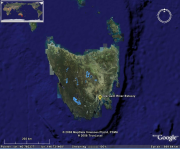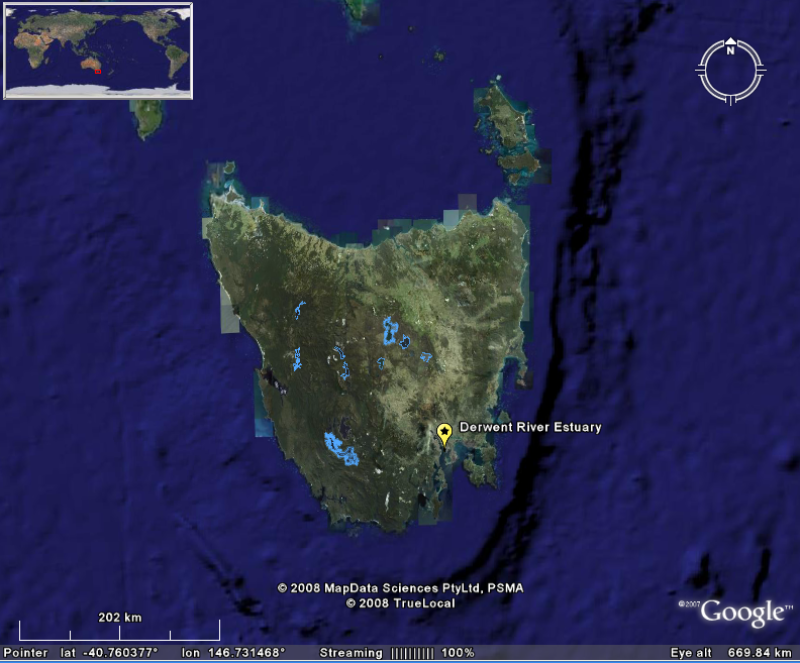Native spider crab predation on Asterias amurensis
This study reports on previously undescribed predation on Asterias amurensis in the Derwent Estuary, Tasmania by the spider crab Leptomithrax gaimardii (Milne Edwards). Specifically, this study describes the predatory interaction between the spider crab and A. amurensis and quantifies patterns of sub-lethal injuries inflicted on the seastar during a localised aggregation of the spider crab.
Simple
Identification info
- Date (Creation)
- 2011-09-14T11:36:00
Principal investigator
School of Zoology, University of Tasmania (UTAS) - Ling, Scott (Honours student)
Private Bag 5
Hobart
Tasmania
7001
Australia
Principal investigator
School of Zoology, University of Tasmania (UTAS) - Johnson, Craig, Prof. (Honours supervisor)
Private Bag 5
Hobart
Tasmania
7001
Australia
- Purpose
- Documentation of in situ predation on the introduced seastar outside of its native northern hemisphere range.
- Status
- Completed
Principal investigator
Institute for Marine and Antarctic Studies (IMAS), University of Tasmania (UTAS) - Ling, Scott, Dr
IMAS - Sandy Bay
Private Bag 129
Hobart
Tasmania
7001
Australia
- Spatial representation type
- Text, table
- Topic category
-
- Biota
Extent
N
S
E
W
))
Temporal extent
- Time period
- 1999-07-01T00:00:00 2000-10-31T00:00:00
Vertical element
- Minimum value
- 3
- Maximum value
- 27
- Identifier
- EPSG::5715
- Name
- MSL depth
- Maintenance and update frequency
- Not planned
Resource format
- Title
- Excel
- Date
- Edition
- 2003
- Global Change Master Directory Earth Science keywords v.5.3.8
-
- Biosphere | Zoology | Echinoderms
- Biosphere | Zoology | Crustaceans
- Oceans | Marine Biology | Marine Habitat
- Biosphere | Ecological Dynamics | Competition
- Biosphere | Ecological Dynamics | Predation
- CAAB - Codes for Australian Aquatic Biota v2
-
- 25 154001
- Asterias amurensis
- 28 880010
- Leptomithrax gaimardii
- Australian and New Zealand Standard Research Classification (ANZSRC): Fields of Research
- Keywords (Theme)
-
- Density
- Sub-lethal damage incidence
- Pattern of sub-lethal damage
- Rate of wound regeneration
- Ray length - seastar
Resource constraints
- Classification
- Restricted
Resource constraints
- Use limitation
- The data described in this record are the intellectual property of S. Ling.
Resource constraints
- Linkage
-
http://i.creativecommons.org/l/by-sa/2.5/au/88x31.png
License Graphic
- Title
- Creative Commons Attribution-Share Alike 2.5 Australia License
- Website
-
http://creativecommons.org/licenses/by-sa/2.5/au/
License Text
- Other constraints
- The citation in a list of references is: citation author name/s (year metadata published), metadata title. Citation author organisation/s. File identifier and Data accessed at (add http link).
- Other constraints
- Contact the researcher for access to data. Data will not be made available until published.
- Language
- English
- Character encoding
- UTF8
- Supplemental Information
- S.D. Ling (2000). The effect of anthropogenic structures on reproductive output of the northern Pacific seastar (Asterias amurensis) in the Derwent estuary. Honours thesis, University of Tasmania. Ling S.D. & Johnson C.R. (in press, 2011). Native spider crab causes high incidence of sub-lethal injury to the introduced seastar Asterias amurensis. International Echinoderm Conference Publication
Content Information
- Content type
- Physical measurement
- Name
- Density
- Name
- individuals per m2
- Name
- Sub-lethal damage incidence
- Name
- Percentage
- Name
- Pattern of sub-lethal damage
- Name
- Rate of wound regeneration
- Name
- Percentage
- Name
- Ray length - seastar
- Name
- mm
Distribution Information
- Distribution format
-
- Microsoft Excel (xls)
Distributor
Resource lineage
- Statement
- In mid-July 1999, a large and sustained aggregation of spider crabs (Leptomithrax gaimardii) occurred in the Derwent Estuary adjacent to the Bellerive Yacht Club (BYC). Near the peak of the aggregation, predator-prey interactions and the incidence of sub-lethal damage to A. amurensis was assessed in situ by divers. Rates of sub-lethal damage were estimated by examining all seastars along 6 belt transects, each 10 x 2 m. Each seastar encountered was assessed for damage which was categorised as either full arm loss (entire arm missing from base of central disc), half arm loss (~50% arm missing by length), or arm tip damage (observed as a ~2-5 mm excision of the distal region of the arm). Evidence of wound regeneration was also recorded. In addition to the survey at BYC, the frequency of seastar damage was also assessed from fortnightly collections of 30 individuals from BYC and an additional 6 sites (in the Derwent Estuary) from late July until ~October depending on site. For each seastar collected, ray length (oral opening to distal end of longest arm) was measured with knife edge callipers to the nearest mm. Prior to diver collections at each site, the density of A. amurensis and L. gaimardii was obtained on each sampling occasion by averaging counts across 6 belt transects (each 10 x 2 m at BYC, DSS and Port of Hobart; 30 x 2 m for Nutgrove Beach, Second Bluff and Tranmere).
- Hierarchy level
- Dataset
Metadata
- Metadata identifier
- be121a6e-e538-4562-9890-84eeb0a69ce2
- Language
- English
- Character encoding
- UTF8
Point of contact
Type of resource
- Resource scope
- Dataset
- Metadata linkage
-
https://metadata.imas.utas.edu.au/geonetwork/srv/eng/catalog.search#/metadata/be121a6e-e538-4562-9890-84eeb0a69ce2
Point of truth URL of this metadata record
- Date info (Creation)
- 2019-03-07T08:24:24
- Date info (Revision)
- 2019-03-07T08:24:24
Metadata standard
- Title
- ISO 19115-3:2018
Overviews

thumbnail

large_thumbnail
Spatial extent
N
S
E
W
))
Provided by

Associated resources
Not available
 IMAS Metadata Catalogue
IMAS Metadata Catalogue